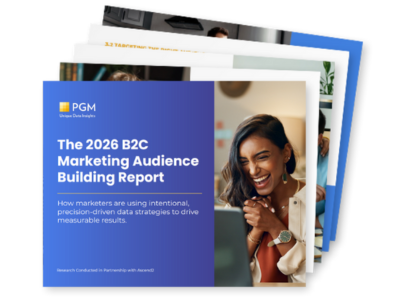If your consumer data could talk, what would it say?
Would it spill secrets about the neighbors down the street moving?
Or maybe Rhonda and Mark just got engaged? They did submit a wedding registry after all.
Has it been monitoring my browsing habits? Yes, I am in the market for a new camera. Thank you very much! And yes, I do see those ads on Instagram. (OK, and I may have clicked on one or two… or three)
The point is, your data is talking. You leave clues to who you are, what you plan to buy, what you like, and when you are looking to make a purchase.
Sometimes the best way to understand what your data is saying is to… well, listen.
Meet the Data Cast – Your Customer Insight Crew
Let’s introduce our dream team of data-driven characters!
Lifestage Larry

Larry is all about milestones. He tracks the big moments in a customer’s life:
- Getting married
- Moving
- New parents
Life events influence needs and spending habits. For example, did you know that new movers spend up to $11,000 on goods and services within the first year of moving. – source from PGM.
This spending includes furniture, home improvement, appliances, internet services, insurance, and more.
Why Larry matters:
Lifestage insights help you offer the right message at the right moment. A new homeowner doesn’t need the same pitch as a recent retiree. Larry makes sure your timing is spot-on and to the right person.
If we asked Larry about me, he’d share that I’m about to graduate college, in a relationship, and ready for the next chapter of my life. He would say I’m the perfect target customer for things like financial planning and buying my first home.
Intent Ivy

Ivy is tuned into behavior, especially the kind that says, “I’m ready to buy.” She watches web browsing, product views, repeat visits, and shopping cart activity. Ivy sees intent before a sale ever happens.
What Ivy tells you:
- Search and browsing behavior
- Purchase triggers
- Abandoned carts and high-interest items
Because when it comes to marketing that actually resonates, demographics only scratch the surface. To truly understand your customers—and deliver messages that stick—you need to look at how they behave. Consumer behavioral data reveals what people do, not just who they are. It’s the difference between guessing and knowing.
Browsing behavior is one of the most valuable forms of behavioral data. It shows what products customers view, how long they spend on your site, which pages they click, and where they drop off. This insight can help you refine everything from product recommendations to content strategy.
For example, if visitors frequently bounce after viewing pricing pages, it may be a signal to simplify your offer or build more trust. Research shows that 81% of retail shoppers conduct online research before buying (GE Capital Retail Bank)
Another powerful category is purchase behavior. This includes what customers buy, how often they buy, and how much they spend. It’s a goldmine for segmenting your audience into high-value vs. one-time buyers, identifying cross-sell opportunities, or re-engaging lapsed customers with relevant offers.
Then there’s email and campaign engagement data—opens, clicks, time-of-day activity, and preferred channels. These signals can help you optimize your outreach strategy and personalize content delivery. If someone consistently clicks on educational content but ignores promotional emails, that’s a clear indicator of what kind of messaging builds trust.
And finally, cart abandonment and retargeting behavior are key. Understanding who left what behind—and when—helps you craft smarter, more personalized remarketing campaigns. Behavioral data gives marketers the ability to respond in real-time to intent, not just identity. Nearly 70% of online shopping carts are abandoned, but emails sent within an hour recover an average of 20% of those sales. – source Baymard Institute / Omnisend
Why Ivy matters:
Intent signals reveal who’s just curious vs. who’s ready to convert. Ivy helps prioritize hot leads and shape campaigns that close the deal.
Ivy would know that I’m someone who loves photography and videography. Constantly browsing and researching the newest cameras, accessories, and tech. As a result of my browsing behavior, she would suggest targeting me with digital ads for cameras and gear, as well as a few new options I hadn’t considered. In the end, I ended up purchasing a model from an Instagram ad.
Property Patty

Patty loves houses and property! She knows when someone bought their home, how much it’s worth, how many square feet it is, and the number of bedrooms. She also has little-known insights on whether your home is in need of window repair or the status of electrical panels.
What Patty tells you:
- Property value and square footage
- interior and exterior home conditions
- Age of home
Why Patty matters:
Understanding someone’s home helps you personalize offers, from suggesting energy-efficient upgrades, to quoting the perfect insurance package.
For example, you can access unique data on a property’s interior and exterior with Home Factors. Home Factors can help you unlock unique insights into over 90% of U.S properties and households. With Home Factors, you can reach homeowners for the exact product and service you may be offering, including:
- Roof Repair or Replacement
- Window Repair or Replacement
- Evidence of Water Intrusion
- Status of Electrical Systems & Insights
Behavioral Ben

Ben is obsessed with patterns. He tracks when, where, and how customers engage with content and brands. He’ll tell you which devices they use, which messages get clicks, and when to send that next promo.
What Ben tells you:
- Preferred communication channels (email, text, social)
- Optimal times and days for engagement
- Content types and product categories that drive interaction
- Repeat visit frequency and browsing sequences
- Devices and platforms customers use most
Why Ben matters:
Ben helps you fine-tune your strategy. Should you send a text or email? Should that ad run in the morning or evening? He knows.
Ben would quickly pick up on how much I’m on Instagram and YouTube every day, along with the specific times when I’m more active on those platforms. Take the NFL, for instance: they post around the same times, because they understand exactly when their fans are most likely to engage. That’s what Ben does – he helps brands pinpoint the perfect moments to send their messages and promote their products.
A Day in the Life: What the Data is Saying Right Now
Let’s have a look into our data crew in action.

- Lifestage Larry reports that Susan just moved to the suburbs with her growing family.
- Intent Ivy notices she’s been searching for backyard playsets and looking at patio furniture on multiple sites.
- Property Patty chimes in; Susan’s new home has a large yard and was recently appraised well above market average.
- Behavioral Ben tracks that she usually shops online around 9 p.m., often on her phone.
What does this all mean?
Susan is on the lookout for targeted offers on outdoor furniture, kids gear, and home improvement services. Now, imagine if you didn’t listen to your data. You might have sent her an email about studio apartment décor instead.
In my case, I may be targeted with ads from ESPN, Fox sports, or any other sports broadcasting network. Since they already know I am interested in the NFL from their data, they will target their ads to what I have shown interest in.
Another example is, I recently was looking at desks for my office. I went to a few different websites, but didn’t purchase anything. Later, and by that, I mean a minute after, when I went on YouTube, I saw one of the desks that I was looking at as an advertisement when I was scrolling through the endless sea of videos.
Listening to your data is important. Consumers will show and tell you what you want, all you need to do is listen.
Why Listening to Your Data Matters
- Data tells a story about who your customer is, what they care about, and what they’re likely to do next, which helps you:Personalize experiences
- Anticipate needs
- Build loyalty through relevance
- Drive better conversion rates
Ignoring your data means missing the bigger picture, or worse, sending the wrong message at the wrong time.
How to Tune In: Making Data Actionable
Want to hear your data loud and clear? Here’s how to get started:
Get your data in order
Before your data can speak clearly, it needs to be clean.
- Accurate contact info
- No messy duplicates
- Fresh, relevant records
When your data is in order, your insights are sharper, your targeting is smarter, and your campaigns actually hit. According to Marketing Scoop, “The average company‘s data contains 20-40% bad records.” Keeping your data clean is a necessity. Think about what could happen if you implemented bad data – Property Patty is all of a sudden advertising a one-bedroom apartment to a family of five.
Collect 1st party data
Your best data is the kind customers give you directly.
- Ask for preferences during sign-up
- Use on-site behavior to shape dynamic content
- Offer value in exchange for data (personalized offers or early access)
The more you know from your own channels, the better you can tailor every message, moment, and offer.
Source third party data sources
Look for trusted partners who offer:
- Verified, privacy-compliant data
- Rich insights like homeownership, demographics, and intent signals
- Seamless integration with your existing platforms
When sourced responsibly, third-party data helps you reach the right people with the right message.
What’s more? In-depth purchasing insights and technology combine to produce your ideal custom marketing audiences.
- Consumer Audience
- Mover and Home Audience
- Automotive Audience
- In-Market Audience
Conclusion: Listen to Your Data
When you give your data a voice and personify it, it’s easy to see how every part flows together. Larry, Ivy, Patty, and Ben tell you exactly what your consumer wants. All you need to do is listen and hear what they have to say. Listen to these actionable insights to build high-performing campaigns that resonate.





